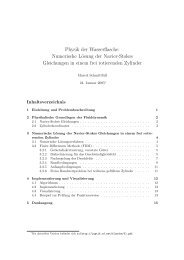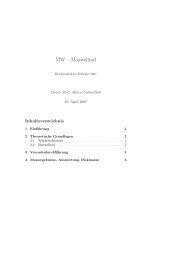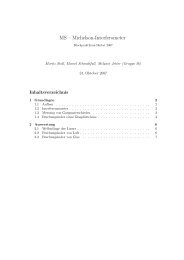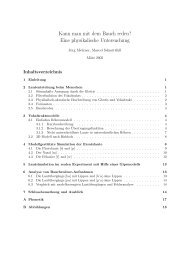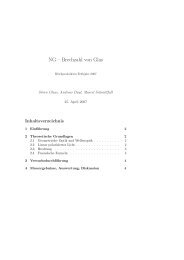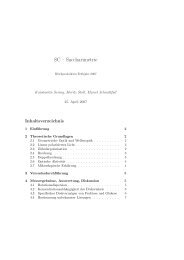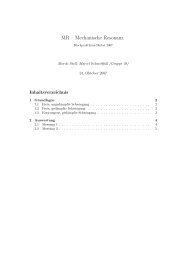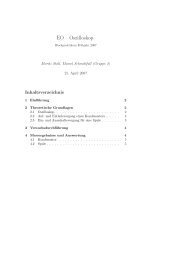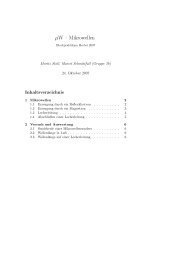JavaPsi - Simulating and Visualizing Quantum Mechanics (english)
JavaPsi - Simulating and Visualizing Quantum Mechanics (english)
JavaPsi - Simulating and Visualizing Quantum Mechanics (english)
You also want an ePaper? Increase the reach of your titles
YUMPU automatically turns print PDFs into web optimized ePapers that Google loves.
3 SOLVING SCHRÖDINGER’S EQUATION 12<br />
Interestingly to note the transmission coefficient D is still greater than<br />
0 if the wave packet hits the wall with a total energy E < V0! I.e. the<br />
probability that a particle with E < V0 is measured after the wall is greater<br />
than 0 — the particle can tunnel the wall.<br />
3.2.5 Harmonic oscillator<br />
Figures 6a until 6c show that a wave packet (3.21) in a harmonic oscillator<br />
potential (c.f. section 3.1.5) oscillates from the left to the right again <strong>and</strong><br />
again. That is the behavior of the particle here is very similar to the classical<br />
description.<br />
3.3 Two-dimensional, time-independent case<br />
Schrödinger equation :<br />
<br />
− 2<br />
2m ∇2 <br />
+ V (x, y) Ψ(x, y) = EΨ(x, y)<br />
Solution: centered space (CS) discretization <strong>and</strong> relaxation yields<br />
ψ(x, y) =<br />
with F (x) from section 3.1.1.<br />
ψ(x + h, y) + ψ(x − h, y) + ψ(x, y + h) + ψ(x, y − h)<br />
4 − h 2 F (x, y)<br />
3.4 Two-dimensional, time-dependent case<br />
Schrödinger equation :<br />
<br />
− 2<br />
2m ∇2 <br />
∂Ψ(x, y, t)<br />
+ V (x, y, t) Ψ(x, y, t) = i<br />
∂t<br />
or<br />
∂ 2 Ψ(x, y, t)<br />
∂x 2<br />
+ ∂2 Ψ(x, y, t)<br />
∂y 2<br />
+i 2m<br />
<br />
∂Ψ(x, y, t)<br />
∂t<br />
− 2m<br />
V (x, y, t)Ψ(x, y, t) = 0<br />
<br />
Solution: forward time, centered space (FTCS) algorithm. Discretization<br />
<strong>and</strong> solving the obtained system yields recursion for Ψ(x, y, t + ∆t) =<br />
Ψr(x, y, t + ∆t) + iΨi(x, y, t + ∆t)<br />
Ψr(x, y, t + ∆t) = c2V (x,y,t)Ψ∂2 r<br />
Ψi(x, y, t + ∆t) = c2V (x,y,t)Ψ∂2 i<br />
Ψ ∂2<br />
(x,y,t)+c1Ψ∂2 i (x,y,t)+c2 1Ψr(x,y,t)−c1c2V (x,y,t)Ψi(x,y,t)<br />
c2 1 +c2 ,<br />
2V (x,y,t)2<br />
(x,y,t)−c1Ψ∂2 r (x,y,t)+c2 1Ψi(x,y,t)−c1c2V (x,y,t)Ψr(x,y,t)<br />
c2 1 +c2 2V (x,y,t)<br />
r (x, y, t) = Ψr(x+∆x,y,t)+Ψr(x−∆x,y,t)+Ψr(x,y+∆y,t)+Ψr(x,y−∆y,t)−4Ψr(x,y,t)<br />
(∆x) 2<br />
Ψ∂2 Ψi(x+∆x,y,t)+Ψi(x−∆x,y,t)+Ψi(x,y+∆y,t)+Ψi(x,y−∆y,t)−4Ψi(x,y,t)<br />
i (x, y, t) = (∆x) 2<br />
with c1 = − 2m<br />
∆t <strong>and</strong> c2 = 2m<br />
2 .<br />
,<br />
,



